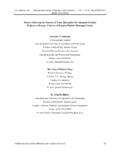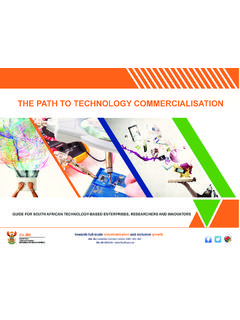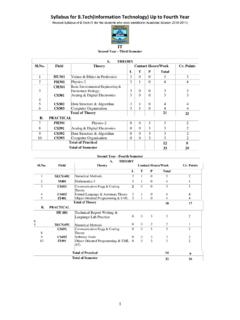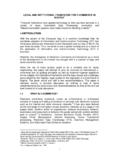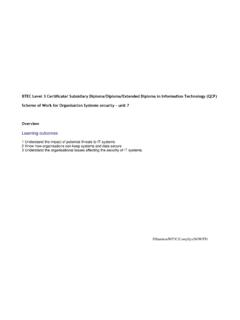Transcription of The relationship between human resources and …
1 11 Carmen Galve-G rriz Ana Gargallo Castel The relationship between human resources and information and communication technologies: Spanish firm-level evidence Journal of Theoretical and Applied Electronic Commerce ResearchISSN 0718 1876 Electronic Version VOL 5 / ISSUE 1 / APRIL 2010 / 11-24 2010 Universidad de Talca - Chile This paper is available online at DOI: The relationship between human resources and information and communication technologies: Spanish firm-level evidence Carmen Galve-G rriz1 and Ana Gargallo Castel2 University of Zaragoza, Department of Business Administration 1 2 Received 21 July 2009; received in revised form 27 November 2009; accepted 17 February 2010 Abstract Increased attention to the economic impact of information and communication technologies (ICT) underscores the impact of ICT on the social side of the digital divide.
2 ICT and individual and organizational changes are often closely related. This paper examines the main characteristics of the relationship between ICT and human resources in Spanish firms, in the context of a developed country with an incidence-rate of ICT slightly below the average of its area. The data on 1,269 Spanish manufacturing firms has been taken from the Survey of Business Strategies (SBS) of the Fundaci n Empresa P blica (Spanish Foundation) of Spain. Our results suggest that ICT are related to higher levels of qualification, higher levels of R&D workers, and higher levels of training per worker. Moreover, firms that invest in ICT offer higher levels of average wages. These results confirm the relationship between technological innovation, and organizational and human changes.
3 Managers and public administrators should take into account such mutual interrelations in order to optimize their decisions concerning investment in human and technological resources . Key words: human resources , Technology, Training, Education, Organizational Change 12 Carmen Galve-G rriz Ana Gargallo Castel The relationship between human resources and information and communication technologies: Spanish firm-level evidence Journal of Theoretical and Applied Electronic Commerce ResearchISSN 0718 1876 Electronic Version VOL 5 / ISSUE 1 / APRIL 2010 / 11-24 2010 Universidad de Talca - Chile This paper is available online at DOI: 1 Introduction The Previous studies in several disciplines management studies, economics, sociology - have analyzed the relationship between technological innovation and human resources ([23], [27], [45], [73]).
4 In general, the widespread use of ICT has been associated with numerous changes in internal business processes, such as organisational structure, job design, requisite employee skills, and so on, aimed at improving flexibility [5], [13], [15]. More specifically, various studies [7], [13], [49] make the link, theoretically and empirically, between the employment effect of firms ICT investments and the impact of ICT diffusion on organizational aspects related to human resources . Berman et al. [17] observe an increase in required skills during the 1980s in the manufacturing sector, which is partly attributed to the introduction of ICT. Using the same decade as a basis, [27] record how the proportion of qualified workers increased, due to the use of computers in firms.
5 Bresnahan et al. [24] argue that firms and workers need to adapt to the use of ICT, and offer empirical evidence, at the firm level, about the relationship between new organizational practices and labor force characteristics. They find that firms that adopt innovation related to ICT, reorganization of work, and development of new products or services, tend to use more qualified workers. Finally, Landry et al. [55] review the changing nature of work in the age of e-business, and highlight significant changes in the life of the organization, coupled with a pronounced movement towards a job market of flexible, fluid groups of highly-skilled, entrepreneurial employees.
6 It may be that advances in ICT usage are exacerbating the difference in employability between the technology-savvy haves and have nots, also known as the digital divide . Recent studies point up the connections between ICT and social inequalities, their impact on wages, employment structure, professional skills, vocational training, etc. ( [19]-[21], [47], [55]). The aim of this paper is to analyse the presence of different standards between those firms adopting ICT, and those not doing so, especially in those aspects related to human resources . This analysis focuses on the case of Spain, where as indicated by [42] the examination of the impact and strategic analysis of ICT is still in its early stages.
7 Furthermore, despite being regarded as a developed country, Spain is slightly below the European average, but is slowly making progress towards an information society, according to data from the Commission of the European Communities [30]. Spain is ranked 31st globally, below Czech Republic, Cyprus and Slovenia, according to The Global Technology Report, 2008-2009 published by the World Economic Forum [74]. All of this makes it interesting to examine in depth the relationships between ICT and human resources among a group of firms in Spain. To examine these effects on Spanish firms, we first offer a literature review, selecting studies on the impact of ICT on inequality, followed by studies on the incidence of this impact on the growth and performance of organizations.
8 Using firm-level data, we then examine the impact of ICT on the introduction of new work practices, as well as on the evolution of wage inequality. The results allow us to identify different groups of firms characterized by different strategic behaviors. Finally, the main conclusions of the article are presented. 2 Theoretical framework As Milgrom and Roberts [58] indicate, a business firm can be regarded as a structure based on contracts between each of its agents, including its employees. The relationships and interdependencies that emerge among those agents require timely information in order to maintain coordination. Moreover, in high-pressure, competitive environments, there is an evident need to effect changes in the organization toward more flexible structures, where specialisation and continuous job-training are key [66].
9 In this context, ICT eases the coordination and flow of information, providing a necessary support for the firm [68]. The modification of the firm's organizational framework is thus made possible, giving way to complex organizations in the shape of a network, as opposed to the previous hierarchies based on centralization, and transferring a fundamental role to its employees through decentralization of decision-making [40], [50], [71]. The introduction of new technologies, and its connection with workforce changes, has been widely reviewed in the academic literature at the firm level [20], resulting in several analyses of the concept known as skill-biased technical change (SBTC). More specifically, SBTC analyses how the introduction of new technologies generates a bias towards more skilled workers, and causes a relative increase in the demand for skilled workers, since these skilled workers are needed in order to use the new technologies correctly [7], [16], [26], [34], [43].
10 A revolution will be slanted in favour of qualified workers (skill-biased) if the new skills are more costly to acquire than those required to operate with old machinery, while it will favour de-qualification (de-skilling) if the new skills can be acquired at a lesser cost than the skills or knowledge associated with pre-existing technologies. Author et al. [6] and Machin and Van Reenen [56] argue that the widespread use of computers is a manifestation of skill biased technological change, which is responsible for the rise in the skill premium. The introduction of ICT will affect a smaller number of unskilled workers, but a greater number of workers with skills and knowledge complementary to innovation and ICT [20], [32], [38].

